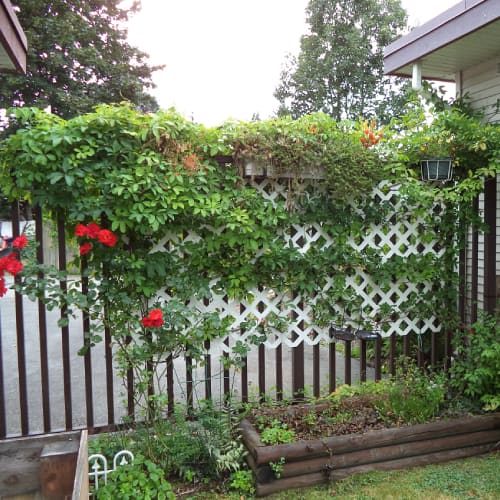
Vines are some of the most versatile plants for naturalizing walls, fences, garden trellises, and arbors. They produce stems that readily trail over vertical structures, encasing them in textural foliage, seasonal blooms, and the occasional bounty of valuable fruits. Some vines persist as annuals, which last for just a few seasons of the year. Deciduous perennials may possess leaves that gradually change color before detaching from their stems in winter. A handful of hardy species boasts year-round foliage, making them reliable as evergreen natural screens.
Evergreen vines are the most ideal options for fences if you intend to boost your property’s privacy. Their hardy stems and branches should sustain their leaf coverage throughout the cooler months of the year. As a bonus, many of these have showy flowers to enhance their visual appeal through spring and summer.
Of course, vines that are evergreen in one region are not necessarily evergreen in others. There are many showy varieties that last all throughout the year in hardiness zones with mild to warm winters. There’s no guarantee that these will also retain their foliage in zones with markedly cold temperatures. Moreover, their exposure to sunlight and moisture may also affect the longevity of their leaves. Before deciding on any of the vines below, pay attention to their hardiness zones and double-check if their general requirements are met by conditions found around your fences.
1) English ivy (Hedera helix)

English ivy is popular as a tough indoor and outdoor vine. Odds are you’ve come across expansive stands of this vigorous climber, which can readily cover walls, fences, trees, shrubs, and other vertical structures without much assistance. It may be considered a pest plant because its escapees can become well-established in wild areas. They may also compete with slow-growing, native flora.
Able to form two types of stems, English ivy has excellent adaptations as a creeping plant. On fences, its infertile stems are likely to produce adventitious roots. These are equipped with sticky pads, allowing them to firmly cling to underlying structures. Their multi-lobed, eye-catching leaves are a characteristic feature. Once these have matured, they may be deep-green or may possess a degree of variegation. Fall blooms and triangular, unlobed leaves are borne on fertile, rootless stems.
Hardy to USDA zones 6 – 12, English ivy may persist as an evergreen vine in regions with moderate to warm winters. It can generously fill in any gaps along picket and wire fences, particularly those that are cast in partial to full shade. In spots with protection from harsh winds and heavy snow, it’s a fantastic choice for creating a reliable natural screen.
2) Winter-flowering clematis ‘Freckles’ (Clematis cirrhosa var. purpurascens ‘Freckles’)
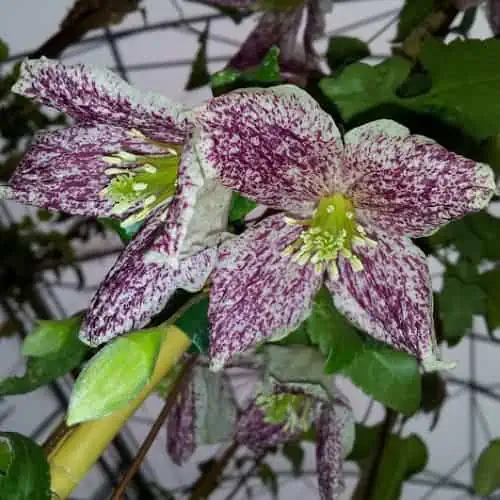
One of the first clematis varieties to produce flowers in early spring, clematis ‘Freckles’ is a stunning addition to the evergreen garden. This vine will have your fences buzzing with winter bees and other pollinators while ambient temperatures are still mildly cool. Its scented, delicate buds open to reveal heavily speckled petals, which are best viewed from a lower angle. To draw attention to the flowers’ speckles, train their stems to trail toward the top of a fence, trellis, or wall.
In the absence of blooms, this evergreen vine continues to provide stunning coverage. Its glossy, toothed leaves may remain green all throughout the year in USDA hardiness zones 7 – 11. Those situated on lengthening stems tend to be most dense under full sun exposure, particularly when the crown of the plant is cast in warm shade. Adding mulch or a layer of stones around the base of the main stem should benefit the plant.
If possible, this winter-flowering clematis should be situated on a south-facing fence. Access to warm light, especially through winter, should help prevent the leaves from dropping. If you’re concerned about the presence of bare stems, which are more likely to occur in zones with inadequate light exposure, try growing winter-hardy shrubs alongside this vine.
3) Trumpet honeysuckle (Lonicera sempervirens)
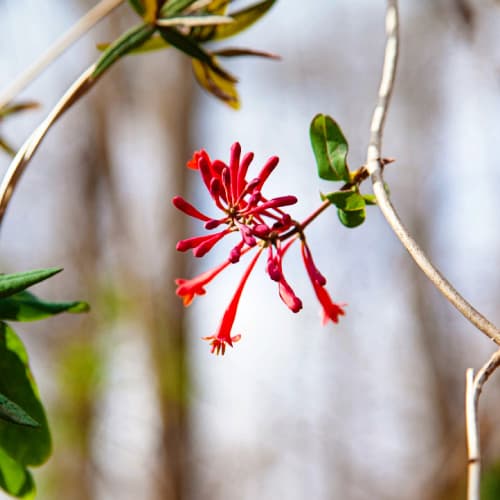
Commonly found in coastal zones with good drainage and slightly acidic conditions, trumpet honeysuckle is known for its cold hardiness. It grows best in USDA zones 5 – 9, where ambient temperatures are fairly mild throughout the year. It is evergreen towards the warmer regions of these zones, whereas it may maintain a semi-evergreen habit in areas with cooler winters. Full sun keeps its stems in good condition, significantly enhancing their capacity to produce and retain their blooms and leaves.
Unmistakable in early spring to summer when its stems are laced with masses of vivid inflorescences, this evergreen vine is irresistible to butterflies, bees, and birds. Its tube-shaped, coral-toned blooms are perfectly suited for pollinators with a lengthy proboscis or a narrow beak, such as the ruby-throated hummingbird, rufous hummingbird, and more. Their stunning color is accentuated by a backdrop of oppositely arranged, oval-shaped leaves.
With sturdy support, this showy honeysuckle can grow to a full height of about 15 feet (4.6 meters). It can quickly cover perforated fences, especially those with foundations in frequently moistened, well-draining substrates.
4) Star jasmine (Trachelospermum jasminoides)
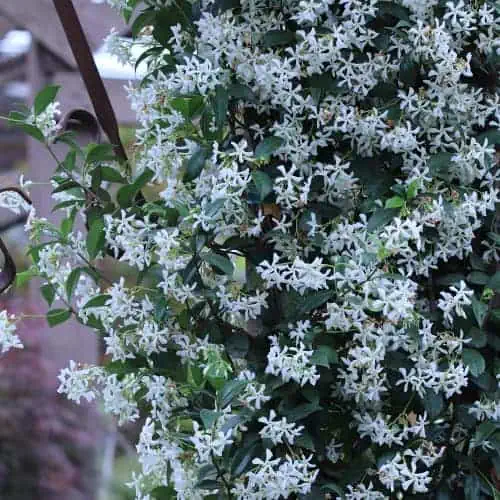
Remarkably textural as a sprawling ground cover or as a trailing plant on fences and walls, star jasmine is a woody liana. In the wild, it grows in shrublands and along the sunlit edges of subtropical to tropical forests. This oriental vine is evergreen in zones with warm winters. One of its cultivars, ‘Madison’, is reputedly more cold-hardy than the type specimen for its species. This cold-tolerant form is more likely to persist as an evergreen vine in USDA hardiness zones 7 – 10.
Clusters of sweetly scented, uniformly white blooms dot the stems of star jasmine through spring and summer. These can transform an entire fence, making passersby stop to admire their simple yet undeniably elegant beauty. Their tendrils can readily wrap around chain-link fences and wooden lattices, securing the shoot’s position and allowing it to grow vertically.
In optimal environments, star jasmine can send out aerial roots at a height of up to 20 feet (6 meters). For this reason, it is often used as a terrace vine in California and in the warmer states of the southeastern US. Its leaves are usually at their healthiest in spots receiving partial sun. Direct morning sun lasting for 2 – 6 hours per day is preferred.
5) Japanese honeysuckle (Lonicera japonica)

Widely grown as an ornamental vine, Japanese honeysuckle is evergreen in regions with moderately warm winters. Hardy to USDA zones 4 – 9, the stems of this cold-tolerant vine may lose their leaves when ambient temperatures drop to below 13˚F (-10.6˚C). They fare well in tropical to subtropical zones but do note that their rate of flower production may be compromised by high summer temperatures. Honeysuckle leaves remain healthy when temperatures don’t exceed 81˚F (27˚C).
Japanese honeysuckle produces twining stems that may reach heights of 15 – 30 feet (4.6 – 9.1 meters) in optimal environments. These can readily twine around fences, trellises, and other vertical structures with ample support. These bear oppositely arranged pairs of oval-shaped, deep-green leaves that measure around 2 – 3 inches (5 – 7.6 cm) long and up to 1.2 inches (3 cm) wide.
In summer, fragrant pairs of tube-shaped blooms are borne as terminal or axillary clusters amongst the leaves. These initially have white petals, but they become increasingly yellowish with time. The pollinated blooms develop into sessile, black berries. Do note that, while birds and other small herbivores may benefit from this vine, it has the tendency to form invasive stands.
6) Carolina jessamine (Gelsemium sempervirens)
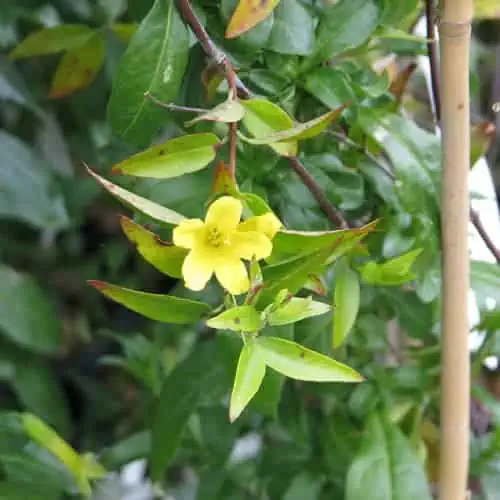
An impeccably charming addition to a planted border or fence, Carolina jessamine is best known for its pollinator-friendly, bright-yellow flowers. In late winter to spring, with some clusters occasionally appearing in fall, the inflorescences attract butterflies and hummingbirds. Each tube-shaped bloom may measure up to 1.5 inches (3.8 cm) across. They are almost as large as the lanceolate leaves, which grow to a full length of about 2 – 4 inches (5 – 10 cm).
Evergreen in hardiness zones 7 – 10, Carolina jessamine has twining stems that can densely weave around and cover vertical structures. As these effortlessly lengthen to a mature length of 10 – 20 feet (3 – 6 meters) over the course of at least three peak growth periods, they can be used to naturalize a fence. The light green leaves may develop purplish hues in winter, but they are unlikely to fall if the vine is watered sparingly and is kept moderately warm through the season.
It’s important to note that this species contains toxic sap. As it may cause skin irritation upon contact, it is advisable to use gloves when pruning or handling the stems. It is deer-resistant and is seldom consumed by mammalian herbivores, so it can be used to create a grazer-repellent fence.
7) Seemann’s hydrangea (Hydrangea seemannii)
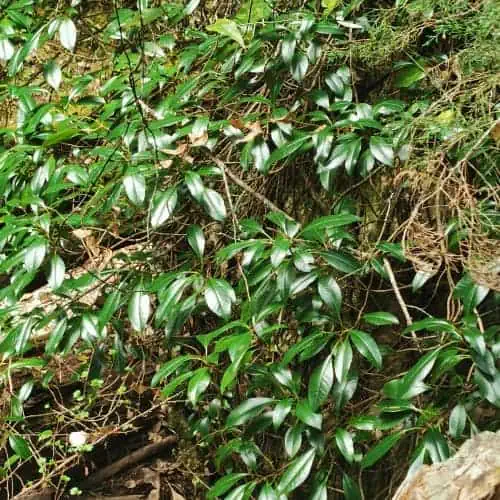
One of the lesser-known climbing hydrangeas due to its preference for sheltered conditions, Seemann’s hydrangea should be cultivated on east or north-facing fences. Its stems thrive best in shade and when they are rooted into consistently moistened and enriched substrates. Full sun may also be tolerated by mature specimens, though these may require more supplementary moisture and increased soil drainage.
Hardy to USDA zones 8 to 10, Seemann’s hydrangea is able to tolerate mild frosts during moderately warm winters. Its evergreen, textural leaves are great for year-round coverage. Deep-green, these are distinctly leathery and look quite attractive even in the absence of blooms. Given optimal ambient conditions, mature specimens produce the loveliest lacecap inflorescences in summer.
Though this climbing hydrangea may take some time to become well-established, its stems are able to grow to a maximum height of about 40 feet (12 meters). In the forests of its native range, it grows as an evergreen liana – creeping towards tree canopies and trailing above shrubs. Given a sturdy fence or lattice around which to twine and lengthen, it should generously add complexity to your garden all throughout the year.
8) ‘Tangerine Beauty’ crossvine (Bignonia capreolata ‘Tangerine Beauty’)
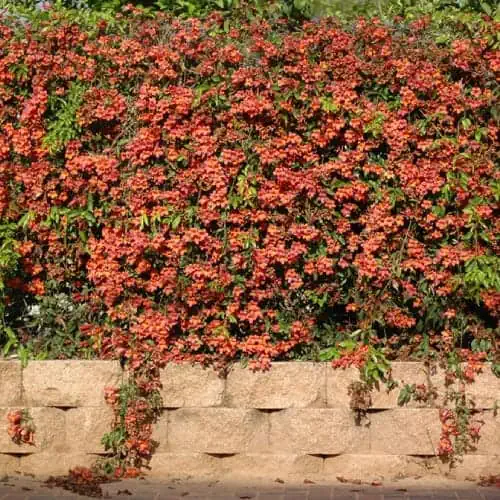
One of the most commonly grown crossvine cultivars in the warmest parts of North America, ‘Tangerine Beauty’ is an outstanding ornamental vine for fences, arbors, pergolas, and lattice-covered walls. This remarkable “Texas Superstar” plant can seasonally transform your garden from spring to fall. In zones with afternoon shade, its woody stems may become awash with vivid, orange blossoms. The deep-green, oblong-shaped leaves are rapidly produced to hide underlying structures.
This crossvine stays securely anchored to fences by sending out branching tendrils – arising from stem sections in between the pairs of leaflets – with adhesive disks. The vine is also able to spread horizontally by sending up suckering roots. In hardiness zones 6 and up, a single specimen may boast a spread of 15 feet (4.6 meters). When provided with enough support, its vertical length may match its width.
In hardiness zones with harsh winter conditions, ‘Tangerine Beauty’ may maintain a deciduous habit and is likely to die back. To protect its dormant roots from frost and disease, its stems may be cut to the ground and its crown covered in mulch. Come spring, a new shoot should appear.
9) Chocolate vine (Akebia quinata)

The chocolate vine is also commonly known as the five-leaf akebia. As suggested by its common names, it sports brownish, chocolate-scented blooms and compound, palmate leaves made up of five smaller leaflets. In the wild, this eye-catching creeper thrives along the edges of streams and forests. Wherever its dense stands occur in sloping and moist areas, its root system aids in minimizing erosion rates.
This oriental vine may maintain an evergreen growth habit in moderately warm, frost-free climates. Its stems may effortlessly grow over shrubs and wind their way towards a tree canopy. In just a single growth period, its height can increase by 20 feet or more! That means that it can naturalize a sturdy fence in almost no time, especially if it is situated under full sun and is rooted in well-draining soil.
The chocolate vine may be easier to manage in cooler zones, where its stems may die back once they are exposed to a prolonged freeze. If you’re interested in making the most out of its ornamental qualities but find its rate of growth a problem, consider planting one of its more compact cultivars. Some of these have stunning variegated leaves and lighter blooms.
10) Persian ivy (Hedera colchica)

The Persian ivy is a close relative of the English ivy, with which it shares its tendency to maintain evergreen coverage. This remarkably versatile perennial is set apart by heart-shaped leaves. Deep-green and noticeably veined, these can attractively cover a fence, trellis, or tree trunk in areas with partial to full shade. When the stems are not provided with vertical structure, they may spread to create a dense and competitive carpet of leathery foliage.
A reliable vine for year-round interest, Persian ivy is hardy to USDA zones 5 – 9. Its leaves are most likely to remain on their stems through warm, frost-free winters. In cooler areas, the crown of the vine may need to be generously mulched once temperatures begin to drop considerably. Though this species favors moderate moisture and partial or dappled shade, it may also thrive on deeply shaded fences and on dry soils.
Without regular pruning, Persian ivy may grow to a height of 15 feet (4.6 meters). It may take as much as 5 years to adequately cover a tall fence. Trimming overgrown stems increases their chances of reaching taller heights. It also helps maintain a more uniform, stately appearance. Some cultivars, such as ‘Sulphur Heart’ and ‘Dentata Variegata’, are cultivated for their colorful leaves.


Anyone have experience with the evergreen vines in our list? Maybe you recommend something different? Feel free to share your experiences/knowledge here in the comments!